KHAJURAHO TEMPLES: Marvels of ancient architecture, art, and philosophy
Shashi Chiplonkar
Khajuraho temples are thousands
of years' old and are more famous for the erotic sculptures attracting tourist
from all over the world. However out of all the sculptures on these temples, not
more than 10% depict eroticism. Furthermore, these sculptures are considered as
symbolizing fertility as a part of human life and also interpreted as a union of
Shiva and Shakti. Another meaning behind the erotic sculptures appears to be of
a tantric cult that are actually metaphors, a form of language, for educating
people about the philosophical essence of human life. Many books, articles and
videos have described the art and architecture of Khajuraho temples. In this blog,
I am elucidating my experience about the Khajuraho temple complex when I visited
in November, 2022. Our trip was organized by Samyana Tours (SAMYANA TOURS LLP in Pune, India
(thesamyana.in)) and expert Indologists Mr Anand Kanitkar and Ms Vidya Gadre were with us to
explain the art, history and philosophy of the sculptures.
Khajuraho temples complex is a UNESCO World heritage site
in Chhatarpur district of Madhya Pradesh, India, about 175 km south-east of
Jhansi city. These are mainly Hindu and Jain temples, and were built by
Chandela kings, Yashovarman, Dhangdev and Vidyadhar, between 950 to 1050 CE. The
name ’Khajuraho’ of this place might have been due to ample khajur (date palm)
trees in this area. Another possibility is that the name has come from the word
Kharjura-vahaka (scorpian bearer), a symbolic name of Shiva.
Khajuraho temple complex spread over 21 sq.km, originally
consisted of 85 temples. Now there are only 25 temples remaining and are
grouped in three areas, ‘Western”, “Eastern” and ‘Southern”. Ten temples are
dedicated to the Hindu God Vishnu, 8 to Shiva, one temple to Sun God, one to
the 64 Yoginis (goddesses) and 5 to the Jain tirthankaras of the Digambar sect.
An inscribed image of Hanuman and that of seated Buddha have also been found at
this site. Though the temples contain sculptures of Gods, daily Pooja is
performed only in Matangeshwar temple.
The “Western” group of temples is near the Shivsagar lake and contains most of the famous temples that are in good condition; namely, Lakshman or Vaikunth-Vishnu temple (built by King Yashovarman in CE. 954), Varah temple (built in CE. 940), Vishwanath temple (built by King Dhangdeva, inscribed CE. 999), Matangeshwar (CE. 1000) and Kandariya Mahadev temple (built by King Viyadhar, CE. 1030). The 64 Yoginis temple (an open-air sanctuary, CE. 900) is at the southwest side the Shivsagar Lake.
Khajuraho temples’
architecture is according to Nagara (Northern) style. Temple is built on a
platform (Jagati), with an entrance porch (Ardha Mandapa) leading to a hall
(Mandapa and Mahamandapa). Then there is a narrow passage (Antarala) which
leads to the main sanctum (Garbhagriha – womb room), wherein the statue or
sculpture of God is situated. There is a small path around the sanctum
(Pradakshina marg). The tall tapering spire (Shikhara), with a special shaped vessel
(Kalash) rises above the temple. One can see the decorative sculptures
portraying Hindu culture on every part of the temple, including entrance, outer
walls, pillars in the Mandapas, and ceilings. It is believed that the style and
sculptures of these temples represent the fundamental principles of entire
cosmos. The art and architectural precision make the Khajuraho temples gorgeous
and unique in conveying social, cultural and emotional aspects of human life in
those times.
1) Lakshmana (Vaikunth
Vishinu) Temple
A light and sound show is presented
every evening around 7.30 pm in front of the main Laxman temple, which describes the love story of a beautiful
woman named Hemavathy and the God Moon. From their son Chandravarman, the
Chandela dynesty started and the show narrates the stories about creation of
temples by the successive Chandela kings.
Chausath Yogini Temple – It is rare to find 64 Yogini temple
anywhere in India. This temple stands on the small rocky platform to
the southwest of the Shivsagar lake. The temple is built entirely of granite
and is oriented north-east and south-west (CE. 900). The temple has an area of
about 104 feet long and 60 feet breadth. There are 65 small cells, one cell was
dedicated to Goddess Kali and the remaining 64 were dedicated to the Yoginis.
Currently only 35 cells have survived. No images or statues remained on any of
the cells. The cells have a roof as shikharas, and the lower
part has triangular ornaments in imitation of the chaitya windows.
Kandariya Mahadev temple:
A large temple of Shiva is believed to have a shape of Mountain Meru, and considered as the center of all physical and spiritual universe. The temple symbolises the yantra plan of the sanctum, cosmic mountain Meru in multi-stepped spire giving a visual expression of Shaiva metaphysical system.
Varaha temple: The statue of the boar (Varaha Avatar of Lord Vishnu) bears images and inscriptions.
b Vaman temple:
Chaturbhuj temple:
It is in Jatkari village built around CE. 1100. This
temple contains a nine feet high, four-armed image of Lord Vishnu with a crown
and ornaments. The upper right hand is in Abhay mudra (giving blessing) with a
circular mark on palm, and a lotus is held in the left hand. A sacred book is
also tied on the left hand with a string. Sculptures of Hindu gods
and goddesses including Lakshmi, Brahma, and Shiva are seen in three rows at
the entrance to the temple. This temple has no erotic sculptures.
Architecture and Sculptures of Khajuraho Temples complex:
The sculptures
include main three types of images; the first ones
are seen near the entrance of the gandharvas, ashta dikpals, attendants and shiv ganas. Second type of
images on the outer walls are of beautiful women in various poses show daily activities such as doing
shringar (makeup), caressing a child, or in a dancing pose. Third type are loving couples (mithunas),
Erotic sculptures:
In Hindu and Jain religion, sex has often been considered to have a philosophical and spiritual base. These temples advocate Tantric philosophy, which says that these erotic images have a different hidden meaning to achieve Moksha or enlightenment. On the outer walls of many temples, especially of the Lakshman temple, there are many images of loving couples in erotic poses. These sculptures are skillfully carved human figures, expressing soft emotions, interactions and affection. One interpretation says that these sculptures show tantric ritual which leads to a path of moksha. Kapalika in Shaiva panth and Tantric in Vaishnava panth were known for their particular rituals. According to Kapalik saint Gorakhnath, the sculpture, where a woman (dombini) is shown sitting on the neck, is a part of a ritual pointing towards a “naadi” (pulse) in the neck. This suggests that “kundalini” has aroused in the chakra in neck and from there it will travel through “sar-chakra” (head/brain). The sculptures of deities like Brahma, Vishnu, Mahesh on one side on walls, and pleasure, desires on the other side, teach the viewer the concepts of righteousness (dharma) and philosophy of life.
Another point of
view about these erotic sculptures indicates the divine union of
Shiva and Shakti to maintain cosmic balance. Shiva is the creative
consciousness, supreme inner soul and Shakti is the pure energy, the supreme
body. Their union implies the life cycle of destruction and evolution.
The spiritual interpretation of the images is supported by the location of the erotic sculptures on the walls, before entering the temple and the garbhgruha (womb room). Hinduism says to leave the desires and earthly longings outside and then enter the temple with a pure mind. These images may help to educate the viewer to move beyond the physical pleasure into higher spiritual goals.
----------------- ***** ------------------- ***** ------------------ ***** ------------ ***** ---------

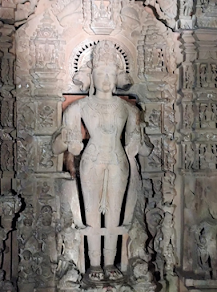















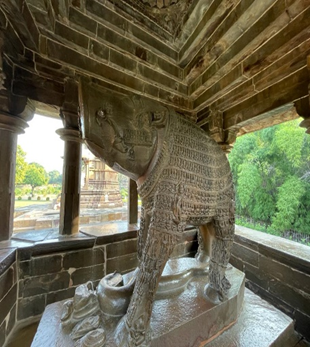




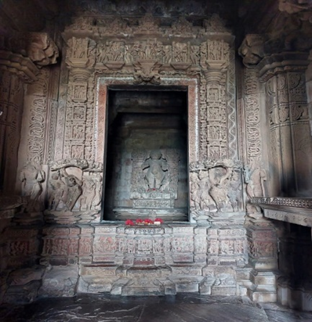



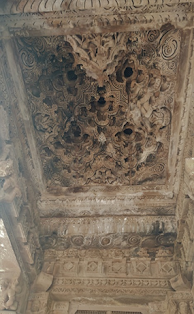











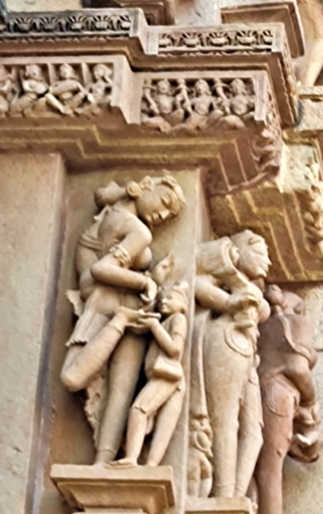
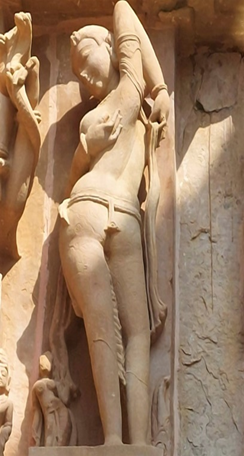














Nice blog 👌
ReplyDeleteExcellent blog ..well explained and neatly presented
ReplyDeleteVery well explained.
ReplyDeleteVery well written and explained.
ReplyDelete